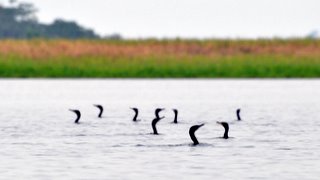The children of Caburini have invited us to join a class in the village school this morning. The school bell is a rusty cylinder of metal, that the teacher, Roni Von, hits with a stick and as he does it, rings and from almost all houses in the village children come walking towards the school. The age ranges from 6 to 12. They are clearly very interested in the visitors. Alberto, Kai, Maxine and Polina introduce themselves and explain the aims of the Minidarwin expedition in the Year of Biodiversity. Then it is the turn of the children from the village. The Minidarwins make a lot of new friends and also see some of their old friends back, like Tatjana, but this time without Tufi. Before we go, we promise them a copy of our book, when it’s published (hopefully also in Portuguese !) and we exchange the addresses.
Roni Von, the school teacher, is also the turtle expert of the village, he’s been trained by the Mamirauá scientists and he is in charge of the turtle management programme of the Caburini village. It’s one of their ways to contribute to the reserve. In exchange, they get some money, or something useful for the village, like diesel for their generator, but especially the assurance that turtles will not be extinct any more.
We have told Ab about the preservation program of the fresh water turtles in which the local people have this important role. So he is joined us on our visit to the Caburini community. Roni Von says they started the turtle protection programme in 2005 and that they have two species of turtles, Acas and Tracajas, whose numbers were decreasing fast before the start of the programme. They take the eggs from the beach as they’re laid by the turtles and take them to a special fenced sandy area in the village, where they wait 40 to 70 days until they hatch. Ab says this kind of action is crucial for the protection of species.
Ab has been involved in establishing a successful protection program for monk seals in the Mediterranean sea, near Greece. « We have started with an enthusiastic group of Greek biologists twenty years ago, when there were only about 600 monk seals left in that area, » he recollects. « Their main threat were local fishermen, who saw a competitor in the seal. The challenge was to convince them that the big fishing trawlers which came to the Mediterranean sea were the real competitors. So a deal was made with the Greek government to install a protected area for the Mediterranean monk seals where access for the trawlers was prohibited.
 |
| Kai learning to blow bubbles with a local plant! |
In the afternoon , we leave the Caburini village, and we all hope to come back meet these wonderful people again one day.
 Monday Aug 9 afternoon
Monday Aug 9 afternoonOur destination is the Mamirauá lake, which gives its name to the entire reserve. Mamirauà actually means « children of the manatee » in one of the original indigenous languages. But we cannot see any manatees this time of the year, since the water level is lowering 14 cm a day and they’ve already left for deeper waters.
On our way there, Ab and Bianca find out they have their interest in birds in common. Sometimes it seems hard for Ab to choose between his binoculars and his camera, to have a closer look on a bird in the trees or in the reeds along the river shore.
Instead of the manatees, we spot a sloth, the very slowly moving animal, hanging on a tree. This is another animal that still puzzles biologists. Because of its slowness, it is very vulnerable when it is on the ground.
Yet it goes pooping always on exactly the same place on the ground near a tree, once a week and scientists still do not know whether they take such a huge risk and use up so much energy to mark their territory or because they like the tree and decide to compost it.
The caimans let us get nearer in the dark, their eyes lighting up like red led’s when our boat with the spotlight approaches. The river water is clean but not clear. At day time you see only the top of the head of the caiman, its eyes, back and tail.
Now we see the whole animal in its prehistoric appearance swimming in the water. Just when we get so near that we can almost touch it (and vice versa), it makes an unpredictable fast move, turns around or lets itself sink into the dark water. This is the move that makes the difference between what seems a floating tree log and a dangerous predator.
Bianca has warned us. The spotlight also attracts other fish which jump into the boat. Still it is totally unexpected that something flickering flies to the air and hits one of us on the chest. One moment later, a small, beautiful silver fish has landed at the bottom of the boat.










No comments:
Post a Comment